Patents
Tuberosity Meter
In 1960, Thomas Scoville received a patent for a device for measuring tuberosity. He explained that the purpose of measuring tuberosity was to improve the fit of chairs:
Even after looking up the meaning of the word 'tuberosity' in the dictionary, it took me a while to figure out what exactly Scoville's device was measuring, and what it possibly had to do with chairs. Because the dictionary simply defined tuberosity as a 'rounded swelling.' Some more googling revealed that Scoville must have been referring to the Ischial tuberosity, or 'sitting bone'. As defined by wikipedia, this is:
Posted By: Alex - Sun May 24, 2020 -
Comments (1)
Category: Body, Furniture, Inventions, Patents, 1960s
Frederick Newbery’s long-distance milk pipes
Frederick Newbery envisioned pipes transporting milk underground from farms directly into cities. He received a patent for this idea in 1874 (No. 148,620). Though as far as I know, his long-distance milk pipes were never put into practice.
Posted By: Alex - Sun May 17, 2020 -
Comments (3)
Category: Inventions, Patents, Nineteenth Century
Exercise Wings
Richard Burgess's 1941 patent (No. 2,244,444) describes a pair of feathered wings that could be attached to the arms of an individual, who would then flap the wings up and down. This, claimed Burgess, would create a sense of buoyancy, while simultaneously providing physical exercise. In particular, it would "develop the chest, back, arm and leg muscles, while also tending to create accelerated breathing and thus general physical tone." It would do all this, he said, while also being "very diverting and accordingly attractive."How did this product never take off?

Posted By: Alex - Sun May 10, 2020 -
Comments (0)
Category: Exercise and Fitness, Inventions, Patents, 1940s
Water-Dispensing Furniture
Thomas Mullenaux of San Pedro, CA was recently granted a patent (No. 10,626,581) for furniture that gathers water from the air via a dehumidifier, collects it in a built-in reservoir, and then allows a person to drink it through a retractable hose.However, in his patent application, Mullenaux never explains why anyone would want or need 'water-dispensing furniture'. I guess it might be useful for those who are too lazy to walk to their kitchen to get a glass of water.


Posted By: Alex - Sun May 03, 2020 -
Comments (2)
Category: Furniture, Inventions, Patents
Informative Swimwear
In 2005, Robert Dickey and Ruth Stephens filed a patent application for "swimwear as information device." Their idea was to make a line of swimwear that displayed maritime signal flags. This would allow people to communicate messages to those around them via their swimwear. They explained:The possible messages one could send seemed limitless, but they were never granted a patent. Perhaps the idea of messages on clothing was deemed too obvious.
There's also the limitation that only people conversant with maritime signal flags could decode the messages, which would make the various 'stay away' messages somewhat pointless.
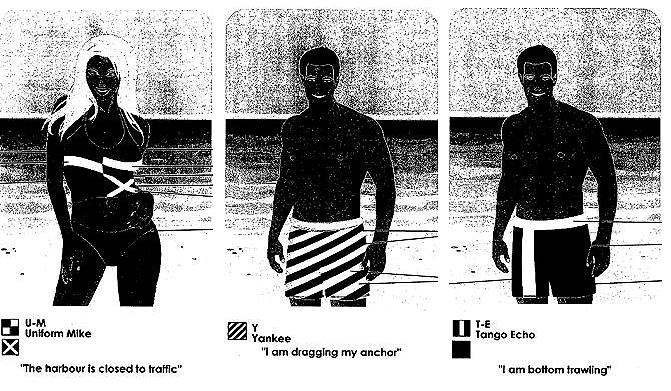
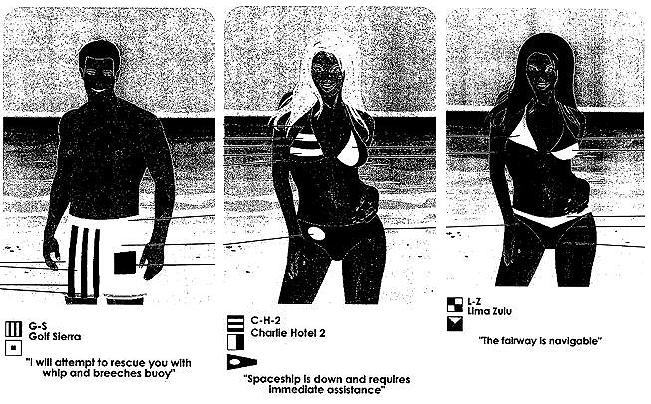
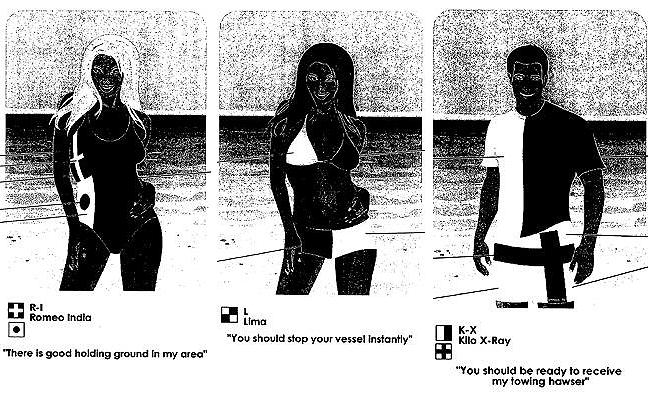
Posted By: Alex - Sun Apr 26, 2020 -
Comments (3)
Category: Boats, Fashion, Inventions, Patents, Languages, Double Entendres and Nudge-Nudge, Wink-Wink
Clean Hands Assured
Claude Davis of Melbourne, Florida obtained a patent for this curious device in 2000. It seems newly relevant in the era of coronavirus.The gadget attached to bathroom doors. Whenever someone turned the handle to open the door, the gadget would spray their hand with dye. This, reasoned Davis, would encourage people to wash their hands, to remove the dye. He imagined his invention might be useful in restaurants and hospitals that have "statutory type hygiene requirements to have their staff and employees clean their hands after using restroom facilities."

Although the invention had good intentions, I can think of several problems with it.
First, I'm sure that most employees would find it incredibly obnoxious to have their hand sprayed with dye every time they went to the bathroom.
Second, wouldn't the gadget also spray dye whenever someone exited the door... spraying into empty air? In which case, half the dye would be wasted. I can imagine employees standing on the inside of the door, pumping away at the door handle until all the dye was used up.
Posted By: Alex - Sun Apr 19, 2020 -
Comments (2)
Category: Bathrooms, Hygiene, Inventions, Patents
Anti-Aging Chair
Hattie Wiener received patents in 1991 and 1993 for an anti-aging chair. The two patents were basically variations on the same theme. The 1991 version of the chair is on the left below, and the 1993 version is on the right.Actually, in the patent write-ups she didn’t mention the anti-aging properties of the chair, but that’s how she described it to the media. She also promoted herself as an “anti-aging consultant.”
The idea was that the chair would force a person to sit upright, and thereby improve their posture and circulation. And this, in turn, would help a person stay healthy as they aged.
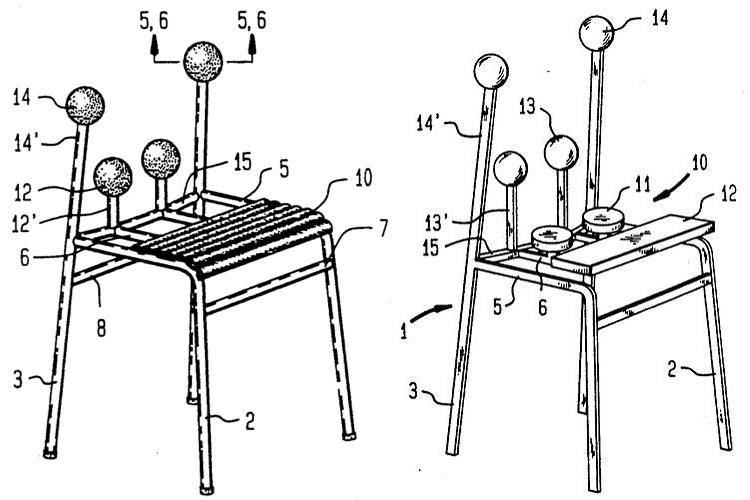
She hoped to sell the chair for $600. A lot for a fairly minimalist piece of furniture. But as far as I can tell, it never made it to market.
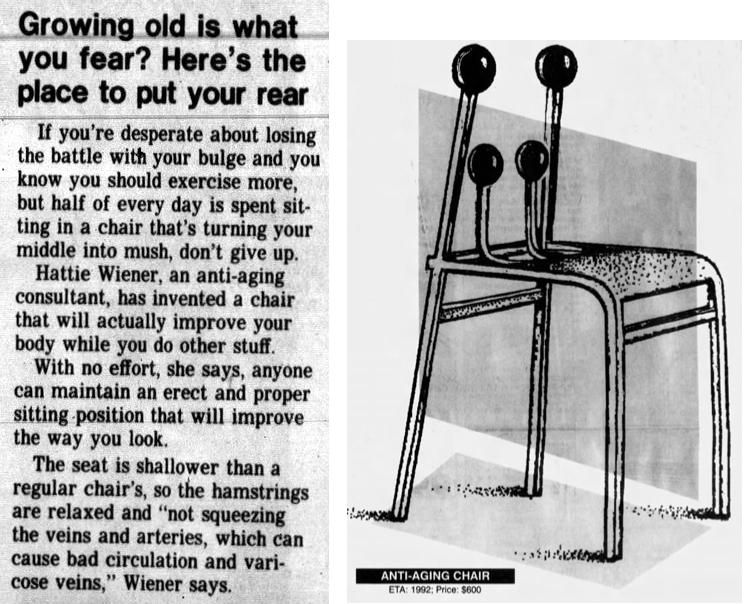
(left) The Desert Sun - Oct 27, 1991; (right) Austin American-Statesman - Nov 10, 1991
Hattie was in her 50s when she patented the chair. Fast-forward almost thirty years, and now, in her 80s, she's still in the news, but for a very different reason. She's become known as the "Tinder Granny," due to her enthusiasm for using the dating app Tinder to find hookups with younger men.
She's certainly defying the stereotypes of age. But I'm disappointed that in none of the recent pictures of her is she using her anti-aging chair. In fact, in the photo below she's totally slouching.
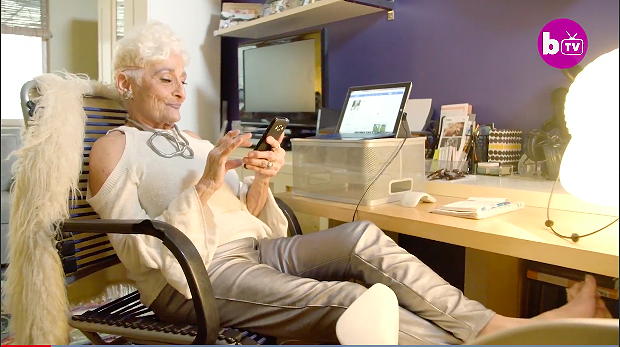
Hattie Wiener, age 83
Posted By: Alex - Sun Apr 12, 2020 -
Comments (2)
Category: Elderly and Seniors, Furniture, Inventions, Patents
Camera Hat
John L. Johnson of Pinehurst, Washington obtained a patent for his "camera support" in 1945. Patent No. 2,369,829. The support provided a way to conceal a camera inside a hat.I wonder if the patent illustration was a self-portrait.

Posted By: Alex - Sun Apr 05, 2020 -
Comments (2)
Category: Inventions, Patents, Photography and Photographers, 1940s
Sardine-Flavored Ice Cream
In 1994, the Japanese Patent Office granted Sato Shigeaki a patent for sardine-flavored ice cream. In his patent application, Shigeaki explained that his intention was to to promote the fishing industry by encouraging children who don't like fish to eat them. He also provided the basic recipe for his sardine ice cream. It involved cooking the sardines with onions, soybeans, rice wine, and walnut paste. Then adding this concoction to a base of chocolate ice cream.This patent enjoys a somewhat unusual distinction. In 1997, European patent examiner Bernard Delporte revealed that it was the most common search request received by his office. He added, "No one believes that it actually exists until they've called it up and seen it themselves."
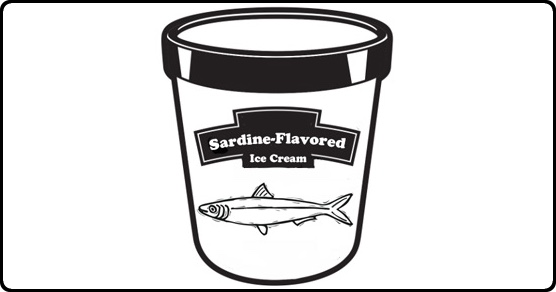
However, further research reveals that sardine ice cream was just the tip of the iceberg of Sato Shigeaki's grand vision. Apparently he imagined using oddball ice cream flavors to boost a broad range of different industries. As seen by the other patents he was granted:
PURPOSE: To enable sales of an ice cream in different types of industries such as the lumber industry and the paper-manufacturing industry, to promote activation of enterprises and to sell the ice cream as a prescribed commodity as a local product by combining white ceder as a tree with ice cream to develop an epoch-making food.
CONSTITUTION: This ice cream is obtained by mixing a naturally extracted edible white ceder spice with an ice cream, mixing a pie dough with an edible white ceder spice, baking the mixture to give a pie, grinding the pie and mixing the flour with an ice cream or combining these ice creams with a designed cake forming a leaf or a twig of white ceder.
JPH06233656A: Sunflower Ice Cream
PURPOSE: To obtain an ice cream of sunflower as a local product.
CONSTITUTION: An ice cream base comprising honey of sunflower is mixed with a sunflower paste prepared by making seeds of sunflower into a paste to give an ice cream. The ice cream is topped with a material obtained by mixing seeds of sunflower roasted by an oven with caramel to give the objective ice cream of sunflower.
JPH11137180A: Salmon Ice Cream
PROBLEM TO BE SOLVED: To obtain salmon-contg. ice cream by mixing salmon in ice cream, and to provide a method for producing the above dessert, intended to offer a new commodity using salmon in the districts noted therefor and accomplished by proposing a technology to lower the freezing temperature of salmon and a second technology to remove the fishy smell inherent in salmon.
SOLUTION: This salmon-contg. ice cream is obtained by mixing salmon flesh boiled with alcohol during ice cream production process followed by chilling (freezing) the resultant mixture.
JPH06217700A: Chinese noodle seasoned with miso ice cream
PURPOSE: To provide a tasty ice cream-based Chinese noodle seasoned with miso intended to activate the relevant market as well as furnish consumers with joyfulness.
CONSTITUTION: Raw noodles are boiled with cow milk and then put into chilled cow milk and cooled. The resultant cooled noodles are boiled with a liquor comprising 80wt.% alcohol, 10wt.% miso and 10wt.% pig bone soup and infiltrated with the alcohol followed by cooling again. The resultant noodles are mixed with an ice cream base which has been separately prepared by incorporating an ice cream base with miso, followed by chilling, thus obtaining the objective ice cream-based Chinese noodles seasoned with miso.
JPH06217699A: Chinese noodle seasoned with soy ice cream
PURPOSE: To provide a tasty ice cream based Chinese noodle seasoned with soy intended to activate the relevant market as well as furnish consumers with joyfulness.
CONSTITUTION: Raw noodles are boiled with cow milk and then put into chilled cow milk and cooled. The resultant cooled noodles are boiled with a liquor comprising 80wt.% alcohol, 5wt.% of soy and 15wt.% seasoned shark fin soup and infiltrated with the alcohol followed by cooling again. The resultant noodles are mixed with an ice cream base which has been separately prepared by incorporating an ice cream base with a seasoned shark fin soup, followed by chilling, thus obtaining the objective ice cream-based Chinese noodles seasoned with soy.
JPH0998722A: Silk ice cream
PROBLEM TO BE SOLVED: To produce silk-contained ice cream perceivable by tongue and eyes that the ice cream contains silk by mixing silk, which is good for health, into ice cream and the unbaked dough of pie, and further spraying silk powder over the baked pie to lay it on the ice cream.
SOLUTION: Silk powder is added and mixed into ice cream base commercial or originally blended which has been sterilized by heating and cooled. Pie dough is also compounded with silk powder, and it is formed into a shape of a silk worm or a cocoon and baked. The pie is placed on ice cream. Silk powder is sprayed over the pie. This enables one to clearly perceive that the pie has silk and to directly taste the silk powder.
JPH08277399A: Cypress flavor for food
PURPOSE: To obtain a cypress flavor for food, having excellent deliciousness, taste and palatability and useful for the preparation of a cake, etc., by adding water to cypress wood chips, heating the chips to distill out a liquid component and removing the water from the liquid by evaporation.
CONSTITUTION: This cypress flavor is produced by adding water to cypress wood chips preferably mixed with false arborvitae wood chips, heating the chips to distill out a liquid component and removing water from the liquid by evaporation.
JPH06233655A: Beer ice cream
PURPOSE: To obtain an ice cream of beer taste having a mellowness and pleasantness to the palate.
CONSTITUTION: The alcohol degree of beer is weakened and mixed with a fresh cream, whole powder milk and a stabilizer so as to prevent the beer from becoming a sherbet state and blended with an ice cream base to give a beer ice.
JPH06343397A: Japanese rice wine ice cream
PURPOSE: To obtain a tasty ice cream having the taste of Japanese rice wine.
CONSTITUTION: The ice cream is obtained by adding SAKE (Japanese rice wine) lees to an ice cream base composed of sugar, cow's milk, an egg, fresh cream, skim milk powder, glucose and a stabilizer and cooling the resultant mixture.
Posted By: Alex - Sun Mar 29, 2020 -
Comments (3)
Category: Food, Inventions, Patents
Cucumber Sandwich Patent
Artist Alex Stenzel not only invented a cucumber sandwich, but in 2006 he managed to obtain a patent for it. It's a design patent, but a patent nonetheless.His idea was to hollow out a cucumber and stuff it with ingredients. He then used one end of the cucumber to plug up the other stuffed side. He called this a 'gorilla sandwich'.

The site dailytitan.com offers some details about how Stenzel came up with his idea:
The name 'Gorilla Sandwich,' according to Stenzel, was chosen after researching gorillas and discovering their diet consists of many greens that are high in protein.
"I'm very much into health," Stenzel said. "I've always been playing around with different types of herbs and different kinds of vegetables."
Stenzel, who is originally from an industrial area in Germany, came across this idea when confronted with a choice: eat his salad at home or store it inside a hollowed-out cucumber to make it portable enough to take to the beach with him. For Stenzel, who is a surfing enthusiast, the answer was obvious, and he was soon off to the beach to 'kiss the waves,' as he calls it, with his new edible invention. Stenzel also has had a world ranking for three different sports: tennis, mountain biking and the Iron Man World Championships in Hawaii in 1986.
"To reach the highest performance level possible, I experimented with different healthy diets," he said.
Stenzel has posted a series of videos on YouTube that provide complete instructions on how you can make your own gorilla sandwich.
Posted By: Alex - Wed Mar 25, 2020 -
Comments (0)
Category: Food, Vegetables, Inventions, Patents

| Who We Are |
|---|
| Alex Boese Alex is the creator and curator of the Museum of Hoaxes. He's also the author of various weird, non-fiction, science-themed books such as Elephants on Acid and Psychedelic Apes. Paul Di Filippo Paul has been paid to put weird ideas into fictional form for over thirty years, in his career as a noted science fiction writer. He has recently begun blogging on many curious topics with three fellow writers at The Inferior 4+1. Contact Us |




